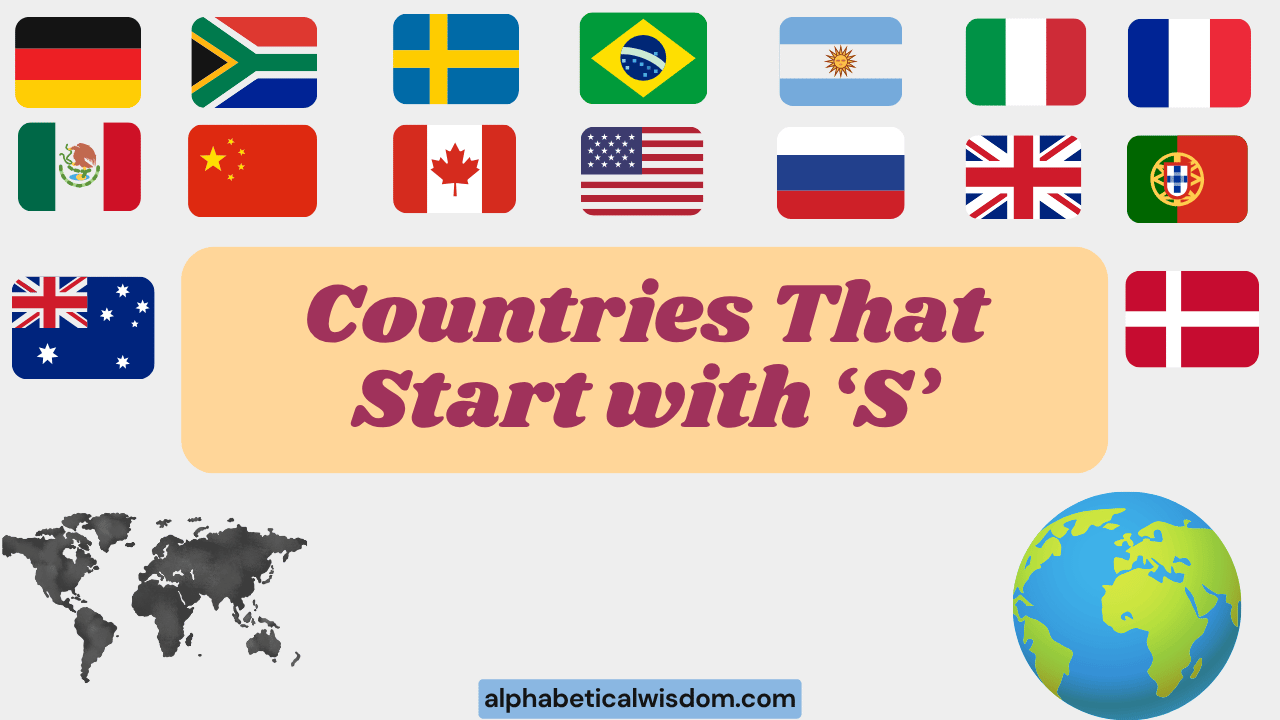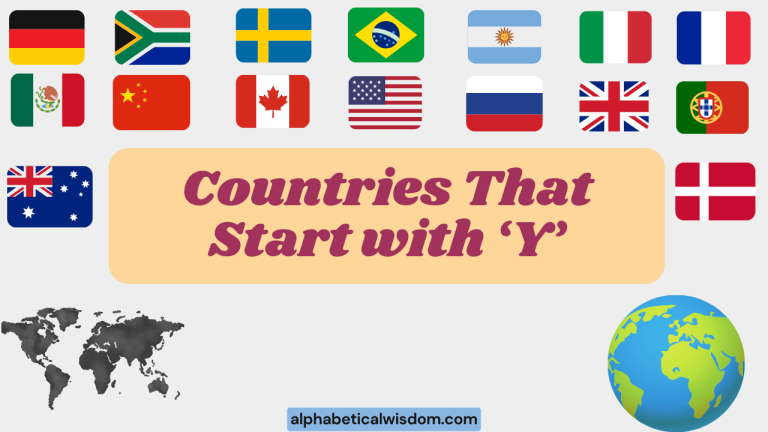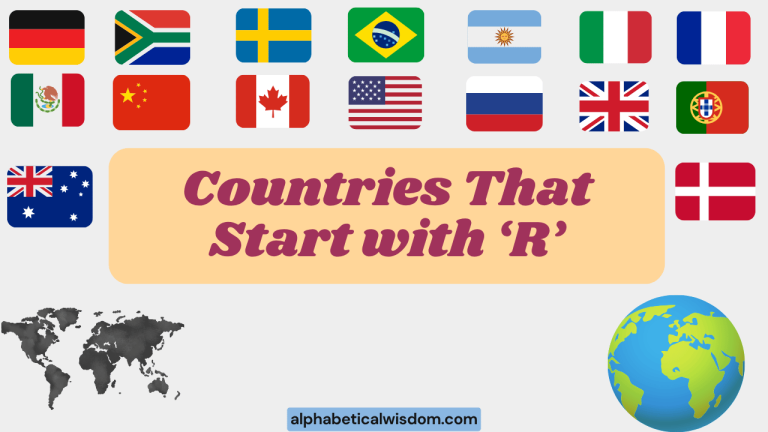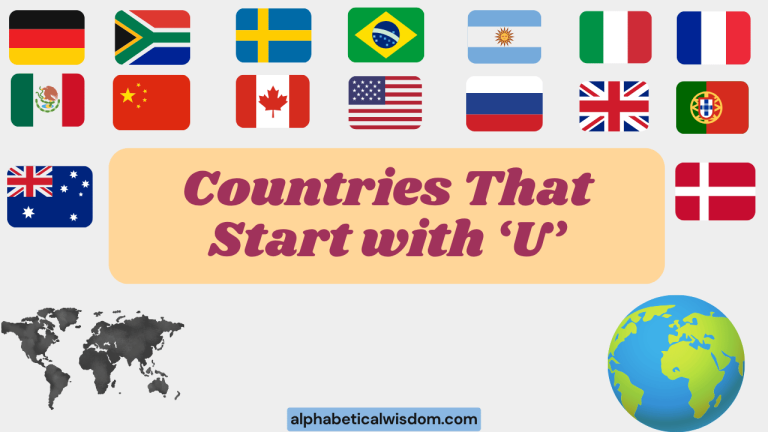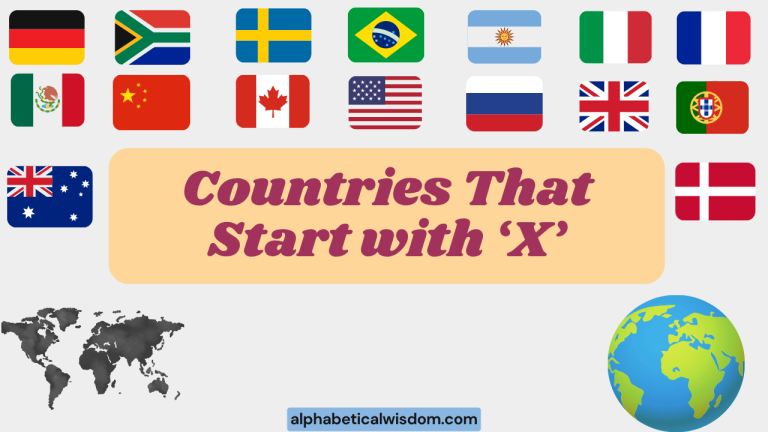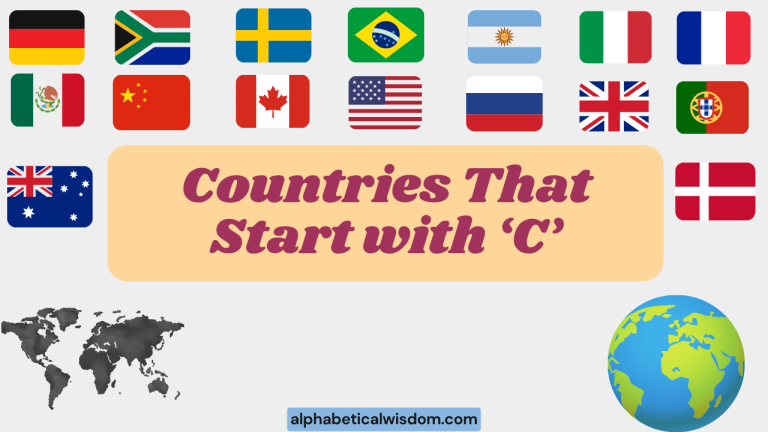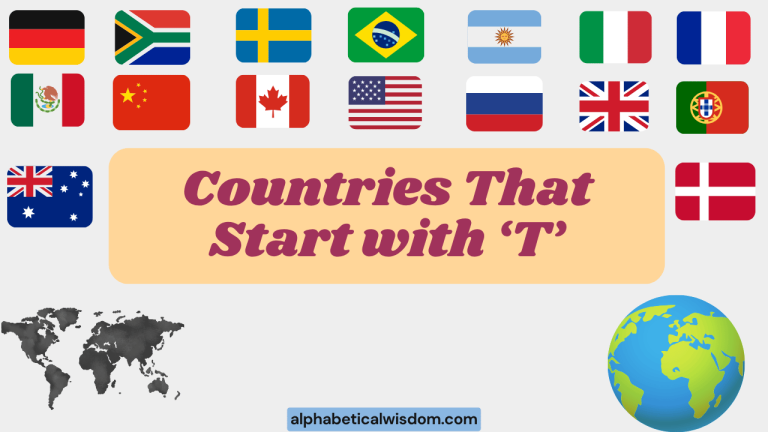Countries Starting With ‘S’: A Grammar & Usage Guide
Mastering the correct usage of country names is essential for clear and effective communication in English. This article focuses specifically on countries whose names begin with the letter ‘S,’ providing a comprehensive guide to their grammatical properties, common pitfalls, and diverse applications.
Whether you’re an ESL student, a seasoned writer, or simply curious about language, this resource will enhance your understanding and accuracy in using these geographical terms.
This guide aims to clarify the nuances of using country names correctly, including articles, plural forms, and adjectival forms. By exploring various examples and practice exercises, you will gain confidence in your ability to discuss international affairs, geography, and cultural topics with precision.
Table of Contents
- Definition and Grammatical Role
- Structural Breakdown
- Types and Categories
- Examples of Countries Starting With ‘S’
- Usage Rules
- Common Mistakes
- Practice Exercises
- Advanced Topics
- FAQ
- Conclusion
Definition and Grammatical Role
A country name is a proper noun that identifies a specific nation or sovereign state. In English grammar, country names function primarily as nouns, serving as subjects, objects, or complements within sentences.
They can also be modified by adjectives or used as adjectives themselves to describe nationality or origin. Understanding the grammatical role of country names is crucial for constructing grammatically correct and meaningful sentences.
Country names are typically capitalized, as they are proper nouns. Some country names require the definite article “the” before them, while others do not.
The choice of whether to use “the” depends on the specific country name and its historical or political context. For example, we say “the United States” but not “the Canada.” This usage often hinges on whether the name implies a union of smaller entities or a descriptive element.
Furthermore, country names have corresponding adjectives, known as demonyms, which are used to describe things or people originating from that country. For instance, the demonym for Spain is “Spanish,” and the demonym for Sweden is “Swedish.” These adjectival forms are essential for describing nationality, culture, language, or origin.
Structural Breakdown
The structure of country names varies significantly. Some are single words (e.g., Sweden), while others are compound names consisting of multiple words (e.g., South Africa).
Compound names often include descriptive elements or indicate a union of smaller regions. The grammatical treatment of these different structures can vary.
Single-word country names generally do not require the definite article “the.” However, compound names, especially those containing words like “States,” “Kingdom,” or “Republic,” often do. For example, “the United Kingdom” and “the Czech Republic” both require “the.” This is because these names refer to specific political entities formed from multiple parts.
The adjectival forms of country names are typically derived from the noun form, often by adding suffixes like “-an,” “-ian,” “-ese,” or “-ish.” For example, “Italian” comes from “Italy,” and “Swedish” comes from “Sweden.” However, there are irregular forms, such as “Dutch” for “the Netherlands” and “Swiss” for “Switzerland.”
Types and Categories
Countries starting with ‘S’ can be categorized based on various factors, including their geographical location, political structure, and linguistic characteristics. This section explores some of these categories to provide a more nuanced understanding of these countries.
Geographical Categories
Countries can be grouped by continent or region. For example, Sweden is a Scandinavian country in Europe, while Sudan is located in Africa.
Singapore is an island nation in Southeast Asia. Understanding the geographical context of a country can provide insights into its culture, history, and language.
Political Categories
Countries can also be categorized by their political systems, such as republics, monarchies, or federations. For example, Switzerland is a confederation, while Spain is a constitutional monarchy.
Somalia, unfortunately, has faced periods of being a failed state with limited central governance. Each political structure has its implications for governance, law, and international relations.
Linguistic Categories
The official language of a country can also serve as a basis for categorization. For example, Spanish is the official language of Spain, while Swedish is the official language of Sweden.
Some countries have multiple official languages, reflecting their diverse populations and cultural heritage. For instance, Switzerland has four official languages: German, French, Italian, and Romansh.
Examples of Countries Starting With ‘S’
This section provides extensive examples of countries starting with the letter ‘S,’ along with their adjectival forms and usage in sentences. These examples are organized into tables for clarity and ease of reference.
Table 1: Examples of Countries Starting with ‘S’ (Part 1)
This table lists countries starting with ‘S,’ their demonyms, and example sentences illustrating their usage.
| Country | Demonym | Example Sentence |
|---|---|---|
| Spain | Spanish | The Spanish language is widely spoken around the world. |
| Sweden | Swedish | Swedish furniture is known for its minimalist design. |
| Switzerland | Swiss | Swiss chocolate is famous for its quality. |
| Sudan | Sudanese | The Sudanese people have a rich cultural heritage. |
| South Africa | South African | South African wines are gaining international recognition. |
| Singapore | Singaporean | Singaporean cuisine is a fusion of many cultures. |
| Somalia | Somali | The Somali language is spoken in the Horn of Africa. |
| Slovakia | Slovak | Slovak folk music is very lively and engaging. |
| Slovenia | Slovenian | Slovenian landscapes are beautiful and diverse. |
| Sri Lanka | Sri Lankan | Sri Lankan tea is world-renowned. |
| Saint Kitts and Nevis | Kittitian/Nevisian | Kittitian and Nevisian culture is vibrant and colorful. |
| Saint Lucia | Saint Lucian | The Saint Lucian economy relies heavily on tourism. |
| Saint Vincent and the Grenadines | Vincentian | Vincentian music has Caribbean influences. |
| Samoa | Samoan | Samoan traditions are deeply rooted in Polynesian culture. |
| San Marino | Sammarinese | Sammarinese citizens take pride in their country’s history. |
| Sao Tome and Principe | Sao Tomean/Principian | Sao Tomean and Principian biodiversity is remarkable. |
| Saudi Arabia | Saudi Arabian | Saudi Arabian oil reserves are among the largest in the world. |
| Senegal | Senegalese | Senegalese music is known for its vibrant rhythms. |
| Serbia | Serbian | Serbian history is rich and complex. |
| Seychelles | Seychellois | Seychellois beaches are pristine and beautiful. |
| Sierra Leone | Sierra Leonean | Sierra Leonean culture is diverse and resilient. |
| Syria | Syrian | Syrian cuisine is flavorful and diverse. |
| South Sudan | South Sudanese | South Sudanese independence is a recent event. |
| Suriname | Surinamese | Surinamese culture is a blend of many influences. |
| Eswatini (formerly Swaziland) | Swazi | Swazi traditions are well-preserved. |
Table 2: Examples with Articles and Plural Forms
This table demonstrates the use of articles (“the”) with country names and provides examples of plural forms where applicable.
| Country | Article Usage | Plural Form (if applicable) | Example Sentence |
|---|---|---|---|
| Spain | No article | N/A | Spain is a popular tourist destination. |
| Sweden | No article | N/A | Sweden has a high standard of living. |
| Switzerland | No article | N/A | Switzerland is known for its neutrality. |
| Sudan | No article | N/A | Sudan faces significant economic challenges. |
| South Africa | No article | N/A | South Africa has a diverse cultural landscape. |
| Singapore | No article | N/A | Singapore is a major financial hub. |
| Somalia | No article | N/A | Somalia has a long and complex history. |
| Slovakia | No article | N/A | Slovakia is part of the European Union. |
| Slovenia | No article | N/A | Slovenia borders the Adriatic Sea. |
| Sri Lanka | No article | N/A | Sri Lanka is famous for its tea plantations. |
| Saint Kitts and Nevis | No article | N/A | Saint Kitts and Nevis is a dual-island nation. |
| Saint Lucia | No article | N/A | Saint Lucia is a popular honeymoon destination. |
| Saint Vincent and the Grenadines | No article | N/A | Saint Vincent and the Grenadines consists of many small islands. |
| Samoa | No article | N/A | Samoa is located in the South Pacific. |
| San Marino | No article | N/A | San Marino is one of the world’s smallest countries. |
| Sao Tome and Principe | No article | N/A | Sao Tome and Principe is an island nation off the coast of Africa. |
| Saudi Arabia | No article | N/A | Saudi Arabia is a major oil producer. |
| Senegal | No article | N/A | Senegal is known for its vibrant music scene. |
| Serbia | No article | N/A | Serbia is located in the Balkans. |
| Seychelles | The | N/A | The Seychelles are famous for their beautiful beaches. |
| Sierra Leone | No article | N/A | Sierra Leone has a rich history and culture. |
| Syria | No article | N/A | Syria is currently facing a severe humanitarian crisis. |
| South Sudan | No article | N/A | South Sudan is the newest country in the world. |
| Suriname | No article | N/A | Suriname is located in South America. |
| Eswatini (formerly Swaziland) | No article | N/A | Eswatini is a landlocked country in Southern Africa. |
Table 3: Adjectival Forms in Context
This table provides more examples of how the adjectival forms (demonyms) of countries starting with ‘S’ are used to describe nationality, culture, or origin.
| Country | Demonym | Example Sentence |
|---|---|---|
| Spain | Spanish | We enjoyed a delicious Spanish paella at the restaurant. |
| Sweden | Swedish | The Swedish government is known for its progressive policies. |
| Switzerland | Swiss | He bought a high-quality Swiss watch as a souvenir. |
| Sudan | Sudanese | The Sudanese refugees are in need of humanitarian aid. |
| South Africa | South African | The South African rugby team is called the Springboks. |
| Singapore | Singaporean | She met a friendly Singaporean businessman at the conference. |
| Somalia | Somali | The Somali pirates were a threat to international shipping. |
| Slovakia | Slovak | The Slovak Republic became independent in 1993. |
| Slovenia | Slovenian | Slovenian cuisine is influenced by Central European traditions. |
| Sri Lanka | Sri Lankan | She purchased a beautiful Sri Lankan sapphire. |
| Saint Kitts and Nevis | Kittitian/Nevisian | The Kittitian coastline is beautiful. |
| Saint Lucia | Saint Lucian | The Saint Lucian economy relies heavily on tourism. |
| Saint Vincent and the Grenadines | Vincentian | Vincentian culture is vibrant and colorful. |
| Samoa | Samoan | Samoan dancing is very captivating. |
| San Marino | Sammarinese | The Sammarinese government is one of the oldest in the world. |
| Sao Tome and Principe | Sao Tomean/Principian | Sao Tomean coffee is very flavorful. |
| Saudi Arabia | Saudi Arabian | The Saudi Arabian desert is vast and impressive. |
| Senegal | Senegalese | Senegalese art is vibrant and expressive. |
| Serbia | Serbian | Serbian music is often melancholic and beautiful. |
| Seychellois | Seychellois | Seychellois Creole is one of the official languages. |
| Sierra Leone | Sierra Leonean | The Sierra Leonean civil war had a devastating impact. |
| Syria | Syrian | The Syrian crisis has displaced millions of people. |
| South Sudan | South Sudanese | The South Sudanese government faces enormous challenges. |
| Suriname | Surinamese | Surinamese cuisine is influenced by many cultures. |
| Eswatini (formerly Swaziland) | Swazi | Swazi culture is rich and traditional. |
Usage Rules
There are several rules to follow when using country names in English. Adhering to these rules ensures clarity and correctness in your writing and speech.
Understanding these rules will help you avoid common errors and communicate more effectively.
Capitalization
All country names must be capitalized, as they are proper nouns. This rule applies regardless of whether the country name is a single word or a compound name.
Capitalization distinguishes country names from common nouns and ensures proper grammatical structure.
Article Usage
As mentioned earlier, some country names require the definite article “the,” while others do not. There is no single rule to determine when “the” is necessary, but here are some guidelines:
- Use “the” with country names that include words like “States,” “Kingdom,” “Republic,” or “Union.” For example, “the United States,” “the United Kingdom,” “the Czech Republic,” and “the Soviet Union” (historical).
- Do not use “the” with single-word country names, such as Spain, Sweden, or Switzerland.
- Country names that are plural in form, like “the Netherlands” or “the Philippines” typically take “the”.
- Island chains and archipelagos, while not always countries, often take “the,” such as “the Bahamas.”
Adjectival Forms (Demonyms)
Use the correct adjectival form (demonym) when describing nationality, culture, or origin. Most demonyms are formed by adding suffixes to the country name, but there are exceptions.
Always double-check the correct form in a dictionary or grammar guide.
Consistency
Maintain consistency in your usage of country names throughout your writing. If you choose to use the full name of a country, stick to that form.
Avoid switching between full names and abbreviated forms unless there is a specific reason to do so.
Common Mistakes
Learners often make common mistakes when using country names. This section highlights some of these errors and provides correct examples to help you avoid them.
Incorrect Article Usage
One of the most common mistakes is using the definite article “the” incorrectly. Here are some examples:
| Incorrect | Correct | Explanation |
|---|---|---|
| I visited the Spain last year. | I visited Spain last year. | “Spain” does not require the definite article. |
| She lives in the Sweden. | She lives in Sweden. | “Sweden” does not require the definite article. |
Incorrect Adjectival Forms
Using the wrong adjectival form can also lead to errors. Here are some examples:
| Incorrect | Correct | Explanation |
|---|---|---|
| He is a Spanishian citizen. | He is a Spanish citizen. | The correct demonym for Spain is “Spanish.” |
| She speaks Swedese fluently. | She speaks Swedish fluently. | The correct demonym for Sweden is “Swedish.” |
Miscapitalization
Forgetting to capitalize country names is another common error. Here are some examples:
| Incorrect | Correct | Explanation |
|---|---|---|
| I want to travel to spain. | I want to travel to Spain. | “Spain” must be capitalized as it is a proper noun. |
| she is from sweden. | She is from Sweden. | “Sweden” must be capitalized as it is a proper noun. |
Practice Exercises
These practice exercises will help you reinforce your understanding of country names starting with ‘S.’ Each exercise focuses on a different aspect of usage, including article usage, adjectival forms, and sentence construction.
Exercise 1: Article Usage
Fill in the blanks with “the” if necessary. If no article is needed, leave the blank empty.
| Question | Answer |
|---|---|
| 1. I am planning a trip to _______ Switzerland. | 1. Switzerland |
| 2. _______ United Kingdom is a member of the Commonwealth. | 2. The United Kingdom |
| 3. She is from _______ Spain. | 3. Spain |
| 4. He visited _______ Czech Republic last summer. | 4. The Czech Republic |
| 5. _______ Seychelles are known for their beautiful beaches. | 5. The Seychelles |
| 6. I have always wanted to visit _______ Sweden. | 6. Sweden |
| 7. _______ Sudan is located in North Africa. | 7. Sudan |
| 8. _______ South Africa is known for its diverse wildlife. | 8. South Africa |
| 9. He is a citizen of _______ Slovakia. | 9. Slovakia |
| 10. She traveled to _______ Slovenia for her vacation. | 10. Slovenia |
Exercise 2: Adjectival Forms
Provide the correct adjectival form (demonym) for each country.
| Country | Demonym |
|---|---|
| 1. Spain | 1. Spanish |
| 2. Sweden | 2. Swedish |
| 3. Switzerland | 3. Swiss |
| 4. Sudan | 4. Sudanese |
| 5. South Africa | 5. South African |
| 6. Singapore | 6. Singaporean |
| 7. Somalia | 7. Somali |
| 8. Slovakia | 8. Slovak |
| 9. Slovenia | 9. Slovenian |
| 10. Sri Lanka | 10. Sri Lankan |
Exercise 3: Sentence Completion
Complete each sentence using the correct form of the country name or its adjectival form.
| Question | Answer |
|---|---|
| 1. The capital of _______ is Madrid. | 1. Spain |
| 2. _______ furniture is known for its simplicity and functionality. | 2. Swedish |
| 3. _______ watches are renowned for their precision. | 3. Swiss |
| 4. Many people in _______ speak Arabic. | 4. Sudan |
| 5. _______ wines are becoming increasingly popular. | 5. South African |
| 6. _______ cuisine is a blend of Malay, Chinese, and Indian influences. | 6. Singaporean |
| 7. The _______ language is spoken in the Horn of Africa. | 7. Somali |
| 8. _______ is a member of the European Union. | 8. Slovakia |
| 9. _______ is a small country bordering Italy, Austria, Hungary and Croatia. | 9. Slovenia |
| 10. _______ is an island nation known for its tea production. | 10. Sri Lanka |
Advanced Topics
For advanced learners, there are more complex aspects of using country names to consider. These topics delve into the nuances of historical names, changing borders, and the political implications of language.
Historical Country Names
Country names can change over time due to political events, such as mergers, splits, or renaming. For example, “Swaziland” officially changed its name to “Eswatini” in 2018.
It’s important to be aware of these changes and use the correct name in context. Referring to “Swaziland” today would be technically inaccurate, though understandable in historical contexts.
Countries with Disputed Territories
Some countries have territories that are disputed by other nations. In these cases, the use of a particular country name can be a political statement.
For example, the status of Crimea is a contentious issue, with different countries recognizing it as part of Russia or Ukraine. Being aware of these sensitivities is crucial for diplomatic and accurate communication.
Language and Political Implications
The official language of a country can have significant political implications. For example, in countries with multiple official languages, the recognition and promotion of each language can be a source of political debate.
Understanding these issues requires a deeper knowledge of the country’s history and culture.
FAQ
This section addresses frequently asked questions about using country names in English.
- Why do some country names require “the” while others don’t?
The use of “the” often depends on the historical and political context of the country name. Names that imply a union of smaller entities or contain descriptive elements (like “States,” “Kingdom,” or “Republic”) often require “the.” Single-word names generally do not. There isn’t a hard and fast rule, and some usage is simply conventional.
- How do I find the correct adjectival form (demonym) for a country?
The best way is to consult a dictionary or a grammar guide. Some demonyms are formed regularly, while others are irregular and must be memorized. Online resources can also provide quick answers.
- What should I do if a country has changed its name?
Use the current official name of the country. If you are referring to a historical event, you may need to use the name that was in use at that time, but clarify the change for your audience.
- Is it okay to use abbreviations for country names?
Abbreviations are acceptable in informal contexts or when space is limited (e.g., in tables or charts). However, in formal writing, it is generally best to use the full name of the country.
- What if I’m not sure about the correct spelling of a country name?
Always double-check the spelling in a reliable source, such as a dictionary or encyclopedia. Incorrect spelling can lead to confusion and undermine your credibility.
- Are there any exceptions to the capitalization rule for country names?
No, country names should always be capitalized, regardless of their position in a sentence or the context in which they are used.
- How do I handle country names in possessive form?
Use an apostrophe + s (‘s) for singular country names (e.g., “Spain’s economy”). For plural country names ending in s, use only an apostrophe (e.g., “The Netherlands’ policies”).
- What if a country has multiple official languages? Which one should I use when referring to its culture or people?
This depends on the context and the specific aspect you are referring to. If you are referring to the country as a whole, you can use a general term (e.g., “Swiss culture”). If you are referring to a specific region or community, you should use the language or demonym associated with that group (e.g., “Italian-speaking Swiss”).
- How do I refer to the people of a country in a general sense?
You can use the demonym as a plural noun (e.g., “The Spanish are known for their passion”). Alternatively, you can use “the people of [country name]” (e.g., “The people of Sweden are known for their innovation”).
- Is it ever appropriate to use informal or slang terms for country names?
Informal or slang terms should be avoided in formal writing and professional communication. They can be offensive or disrespectful, and they may not be understood by all audiences. It’s always best to use the official name of the country.
Conclusion
Mastering the usage of country names, especially those starting with ‘S,’ involves understanding their grammatical roles, structural variations, and specific rules regarding articles and adjectival forms. This comprehensive guide has provided you with the knowledge and tools to use these names accurately and confidently in your writing and speech.
By paying attention to capitalization, article usage, and demonyms, you can avoid common mistakes and communicate more effectively about international topics.
Remember to practice regularly using the exercises provided and to consult reliable sources when in doubt. Language learning is an ongoing process, and continuous practice is the key to improvement.
With dedication and attention to detail, you can master the nuances of English grammar and enhance your overall communication skills.
